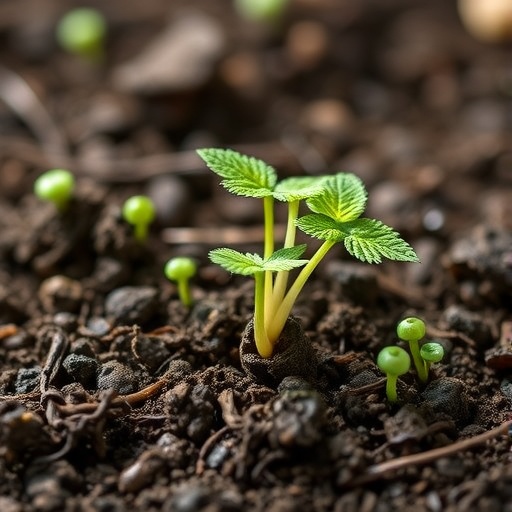In the quest to sustainably enhance agricultural productivity, soil microbes have emerged as pivotal allies, assisting plants with nutrient acquisition and bolstering resistance to diseases. However, unlocking the full potential of these microbial communities has been hindered by a crucial factor: a large fraction of soil microorganisms exist in a dormant state, inactive and inert within the soil matrix. The transition from dormancy to activity is essential for microbes to successfully colonize plant roots and thrive within plant tissues. This fundamental aspect of microbial ecology remained elusive until a groundbreaking study by researchers at Penn State unveiled a novel approach to disentangle the complex relationship between microbial activity and root colonization success.
The investigation centered on crimson clover (Trifolium incarnatum), a legume widely adopted as a cover crop in the northeastern United States, known for its symbiotic association with nitrogen-fixing bacteria housed in root nodules. This choice allowed researchers to observe microbial dynamics across a gradient encompassing the soil adjacent to roots (the rhizosphere), the root surface, and the internal root environment (the endosphere). Employing a pioneering chemical-labeling method named BONCAT (bioorthogonal non-canonical amino acid tagging), the team was able to specifically tag newly synthesized proteins within active microbes, providing an unprecedented snapshot of microbial metabolic status over defined time windows.
Integrating BONCAT with flow cytometry—a technique that analyzes and sorts individual cells based on fluorescence—and sequencing of specific genetic markers enabled the researchers to isolate and identify the subset of metabolically active microbes, distinct from the broader dormant community. This methodological innovation facilitated a deep dive into the functional aspect of microbial communities that traditional DNA-based surveys, which capture total microbial presence regardless of activity, could not resolve.
Remarkably, the results demonstrated that microbial activity within the plant endosphere was approximately tenfold higher than in adjacent soil compartments, reflecting the nutrient-rich environment supplied by plant tissues. This gradient implied that proximity to, and residence within, plant roots create metabolic niches favoring active microbial proliferation. Crucially, active microbes in the rhizosphere were far more likely to successfully infiltrate and colonize the plant than those merely abundant but metabolically inactive, challenging previous assumptions that microbial abundance alone dictates colonization.
This discovery underscores that microbial activity is a more informative predictor of root colonization success than sheer microbial numbers. It also highlights the selective pressures exerted by plant roots that seemingly “wake up” specific microbial taxa from dormancy, priming them for beneficial interactions. While a multitude of microbial families exist in soil, only a subset overcomes dormancy barriers to engage meaningfully with plants, suggesting a finely tuned ecological filtering mechanism.
The study’s first author, Jennifer Harris, notes that understanding the triggers and mechanisms that enable dormant microbes to exit metabolic stasis near plant roots is an imperative next step. Deciphering these cues could unlock strategies to manipulate microbial communities, fostering the activation of beneficial taxa and optimizing plant-microbe symbioses. Such knowledge could revolutionize the design of microbial inoculants—commercial preparations aimed at enhancing crop health—which often falter in field conditions due to reliance on lab-grown strains whose activity profiles differ from wild soil microbes.
Senior author Estelle Couradeau emphasizes that this research signifies a paradigm shift. By focusing on microbial activity rather than mere presence, scientists gain a functional lens to discern which microbes truly contribute to plant health. The use of BONCAT inside plant tissues marks a first in microbial ecology, providing direct visualization and identification of active microbes within their natural habitat.
This approach opens avenues not only for improving agricultural inoculants but also for broader applications in understanding soil and plant microbiomes. Insights into microbial dormancy and activation cycles hold promise for sustainable agriculture by enabling precision management of microbial consortia, reducing reliance on chemical fertilizers, and enhancing crop resilience amidst environmental challenges.
The research benefited from collaborative expertise spanning soilborne disease dynamics, plant science, and microbiology, showcasing the interdisciplinary nature essential for such complex inquiries. It leveraged cutting-edge facilities at Penn State’s Huck Institutes, including flow cytometry and genomics cores, exemplifying the integration of advanced technologies to unravel environmental microbiology’s intricacies.
Supported by the U.S. Department of Agriculture’s National Institute of Food and Agriculture, this investigation contributes valuable foundational knowledge with practical implications. By elucidating the critical role of microbial activity over abundance in the rhizosphere-root nexus, it sets the stage for next-generation strategies in microbial ecology and sustainable crop management.
In summary, this pioneering work reveals that the microbial life poised to influence plant health is not simply present but actively metabolizing and interacting with plant roots. Harnessing this active microbial fraction by decoding the mechanisms governing their dormancy exit and root colonization behavior may revolutionize how agriculture harnesses the invisible yet mighty forces beneath our feet.
Subject of Research: Soil microbial activity and root colonization in crimson clover (Trifolium incarnatum)
Article Title: The activity of soil microbial taxa in the rhizosphere predicts the success of root colonization
News Publication Date: 6 August 2025
Web References:
DOI: 10.1128/msystems.00458-25
Image Credits: Penn State
Keywords: Soil science, rhizosphere microbiota, microbial dormancy, plant-microbe interactions, BONCAT, flow cytometry, soil microbiology, root colonization, crimson clover, sustainable agriculture




